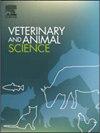Modeling growth curve parameters in Peruvian llamas using a Bayesian approach
IF 1.9
Q2 AGRICULTURE, DAIRY & ANIMAL SCIENCE
引用次数: 0
Abstract
The objective of this study was to fit four nonlinear models (Brody, von Bertalanffy, Gompertz and Logistic) to realizations of llama weight, using frequentist and Bayesian approaches. Animals from both sexes and types (K'ara and Ch'accu) were observed. Data consisted of 43,332 monthly body weight records, taken from birth to 12 months of age from 3611 llamas, collected from 1998 to 2017 in the Quimsachata Experimental Station of the Instituto Nacional de Innovación Agraria (INIA) in Peru. Parameters for Non-linear models for growth curves were estimated by frequentist and Bayesian procedures. The MCMC method using the Metropolis-Hastings algorithm with noninformative prior distributions was applied in the Bayesian approach. All non-linear functions closely fitted actual body weight measurements, while the Brody function provided the best fit in both frequentist and Bayesian approaches in describing the growth data of llamas. The analysis revealed that female llamas reached higher asymptotic weights than males, and K'ara-type llamas exhibited higher asymptotic weights compared to Ch'accu-type animals. The asymptotic body weight, estimated for all data using the Brody model, was 42 kg at 12 months of age in llamas from Peru. The results of this research highlight the potential of applying nonlinear functions to model the weight-age relationship in llamas using a Bayesian approach. However, limitations include the use of historical data, which may not fully represent current growth patterns, and the reliance on non-informative priors, which could be improved with prior knowledge. Future studies should refine these aspects.
用贝叶斯方法模拟秘鲁大羊驼的生长曲线参数
本研究的目的是拟合四个非线性模型(Brody, von Bertalanffy, Gompertz和Logistic),利用频率论和贝叶斯方法实现骆驼体重。观察了不同性别和类型(K'ara和Ch'accu)的动物。数据包括1998年至2017年在秘鲁国立Innovación农业研究所(INIA) Quimsachata实验站收集的3611头大羊驼从出生到12个月的43332个月体重记录。用频率算子和贝叶斯方法估计了生长曲线非线性模型的参数。将非信息先验分布的Metropolis-Hastings算法的MCMC方法应用于贝叶斯方法。所有非线性函数都能很好地拟合实际体重测量值,而Brody函数在描述大羊驼的生长数据时,在频率论和贝叶斯方法中都提供了最好的拟合。结果表明,雌性大羊驼的渐近体重高于雄性大羊驼,K’ara型大羊驼的渐近体重高于Ch’accu型大羊驼。使用Brody模型估计的所有数据,秘鲁大羊驼12月龄时的渐近体重为42公斤。本研究结果强调了利用贝叶斯方法将非线性函数应用于大羊驼体重-年龄关系建模的潜力。然而,局限性包括历史数据的使用,这可能不能完全代表当前的增长模式,以及对非信息性先验的依赖,这可以通过先验知识来改进。未来的研究应该完善这些方面。
本文章由计算机程序翻译,如有差异,请以英文原文为准。
求助全文
约1分钟内获得全文
求助全文
来源期刊

Veterinary and Animal Science
Veterinary-Veterinary (all)
CiteScore
3.50
自引率
0.00%
发文量
43
审稿时长
47 days
 求助内容:
求助内容: 应助结果提醒方式:
应助结果提醒方式:


